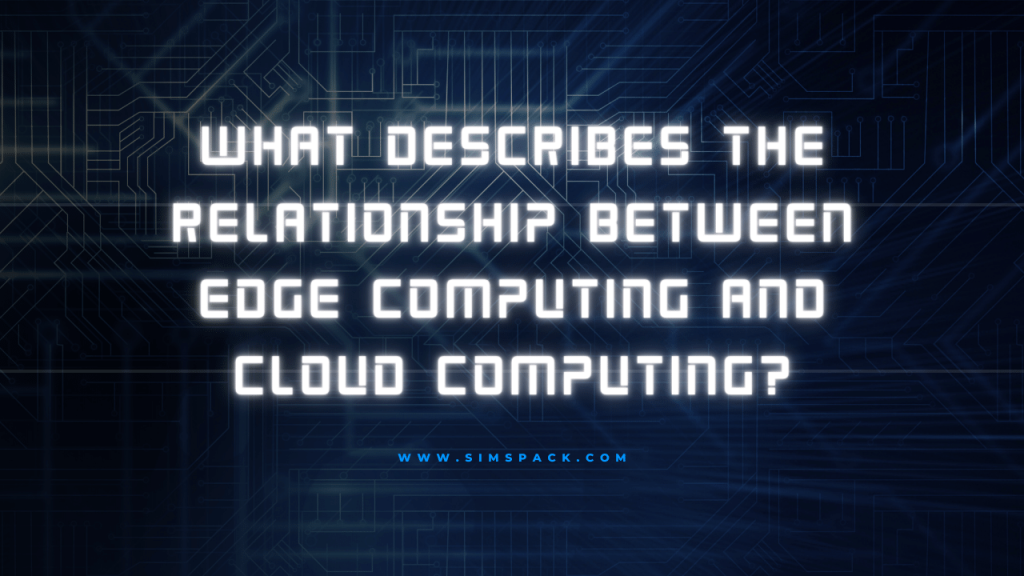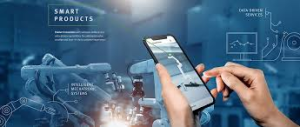In the realm of digital technology, there’s a constant evolution of ideas and solutions geared towards enhancing efficiency, speed, and reliability of data processing and management. Two key players in this evolution are Edge Computing and Cloud Computing. Together, they bring a perfect blend of innovation that is shaping the future of data management. Let’s delve into “What Describes the Relationship Between Edge Computing and Cloud Computing?”.
Edge Computing vs. Cloud Computing: Complementary or Competitive?
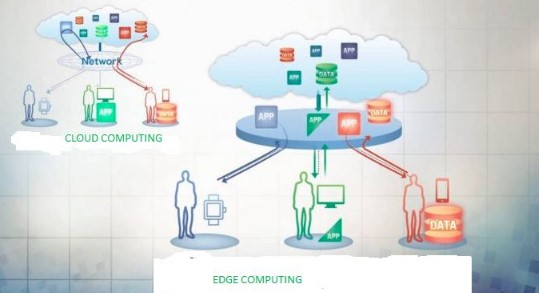
Before we can comprehend the interplay between edge and cloud computing, it’s vital to understand what they are individually. Cloud computing is a model that enables on-demand access to a shared pool of computing resources, all hosted online. It offers scalability, robustness, and cost-efficiency, being a go-to solution for many businesses.
On the other hand, edge computing is a distributed computing paradigm that brings data storage and computation closer to the location where it’s needed, to enhance response times and save bandwidth. Edge computing offers real-time data processing without latency, allowing smart applications and devices to respond to data almost instantaneously, as it’s being created, eliminating lag time.
So, are edge computing and cloud computing competitors? Quite the opposite. They are complementary technologies. Edge computing can be viewed as a distributed layer, an extension of the cloud to be more precise, designed to solve some of the challenges cloud computing faces in terms of latency and bandwidth usage.
Unlocking the Power of Edge and Cloud Integration
When the cloud and edge computing are brought together, they offer unique advantages that cannot be achieved independently. This integrated solution becomes a powerhouse that leverages the strengths of both technologies while offsetting their individual weaknesses.
For instance, in scenarios where low latency is paramount, edge computing steps in to deliver instant processing. On the flip side, when dealing with massive amounts of data, or complex analytics and machine learning tasks that need substantial resources, cloud computing shines.
Moreover, the combination of edge and cloud can bring about a significant reduction in costs. The edge can filter and process data locally, sending only vital information to the cloud, thus reducing transmission costs. Additionally, by decreasing reliance on cloud data centers for every task, companies can also cut operational costs.
Security Considerations: Edge and Cloud Hand-in-Hand
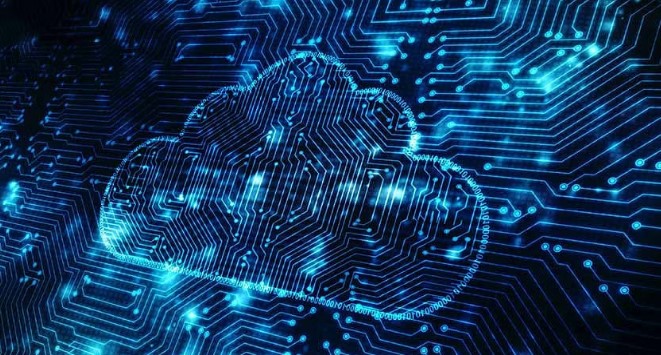
In the modern digital era, security is paramount. Cloud security has always been robust, but the inclusion of edge computing amplifies the security paradigm. Edge computing helps distribute data and applications across multiple locations, which can provide a layer of security through obscurity. Furthermore, edge devices can be designed to use secure methods to communicate with the cloud, adding an extra layer of protection.
It’s also worth noting that edge computing can support the cloud in meeting regulatory compliance requirements. In industries where data sovereignty and privacy are important, data can be processed and stored locally on edge devices, reducing the potential risks of data breaches and privacy invasion.
Cloud-Native Edge Computing Frameworks: An Emerging Hybrid Model
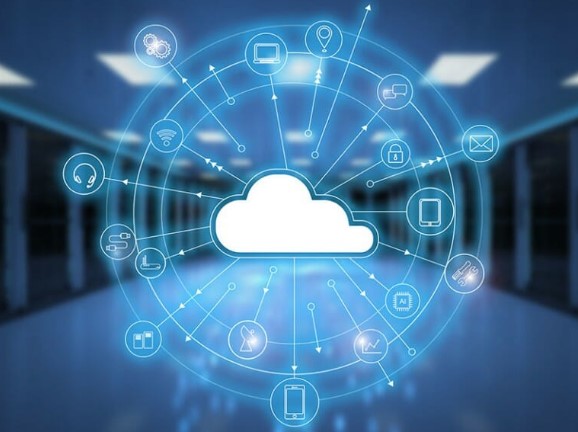
There is an emerging trend in the integration of edge computing and cloud computing: cloud-native edge computing frameworks. In these frameworks, the cloud serves as a central orchestrator, managing and coordinating the functions of edge nodes. This model allows for the seamless, flexible, and scalable deployment of applications that can take advantage of resources at both the edge and the cloud, offering an unprecedented level of efficiency and flexibility.
The Future of Edge and Cloud: A Dynamic Duo
Looking forward, the relationship between edge computing and cloud computing will only deepen. Businesses and industries that rely on immediate data analysis, such as IoT devices, autonomous vehicles, telemedicine, and many more, will increasingly rely on the edge-cloud duo. Moreover, as technologies evolve and more edge devices get deployed, the integration of edgeand cloud computing will likely become a standard architectural design.
Exploring Real-World Applications of Edge and Cloud Integration
The amalgamation of edge computing and cloud computing doesn’t just exist in theory. Several real-world applications testify to the power of this innovative relationship.
Internet of Things (IoT) and Smart Devices
In the realm of IoT, devices generate data in real-time and require prompt processing for optimal performance. The integration of edge and cloud in IoT scenarios allows for real-time data processing at the edge, where IoT devices are located, while the cloud can be used for extensive data analysis and long-term storage.
For example, smart home devices like thermostats, security systems, or intelligent assistants need to respond in real-time to user commands. Here, edge computing processes data instantly, offering the required low latency, while the cloud ensures data backup and updates for the devices.
Autonomous Vehicles
The automotive industry, particularly autonomous vehicles, also benefits greatly from the edge-cloud combination. Self-driving cars need to make instant decisions based on the data they collect from their sensors. Delays in processing could lead to catastrophic outcomes. Edge computing plays a pivotal role here by processing data on the vehicle itself (the edge), thus ensuring real-time responses.
At the same time, the cloud is crucial for tasks such as mapping, updating software, and analyzing data from numerous vehicles to improve autonomous driving algorithms.
Healthcare
The healthcare sector has also embraced the integration of edge and cloud computing. In telemedicine, wearable devices collect patient data in real-time. Edge computing enables instant analysis of this data to provide immediate feedback to patients or alert healthcare professionals in case of an emergency.
Simultaneously, the cloud plays an integral role in storing patient data securely, enabling remote consultations, and using advanced analytics for predictive diagnosis.
Manufacturing
In the manufacturing industry, edge computing allows for real-time monitoring and control of manufacturing processes, thus enhancing efficiency and reducing downtime. Cloud computing, on the other hand, can be used to analyze the data collected from various manufacturing plants, leading to insights that can improve operations, maintenance, and planning.
Overcoming Challenges in Edge-Cloud Integration
While the integration of edge computing and cloud computing offers numerous benefits, it also presents some challenges. One such hurdle is ensuring seamless data flow and interoperability between edge devices and cloud systems. Solutions involve developing standardized protocols and interfaces for communication between edge and cloud platforms.
Additionally, the distributed nature of edge devices adds a layer of complexity in terms of management and security. Employing cloud-based edge management systems can help overcome these challenges by providing centralized control over distributed edge devices.
Furthermore, maintaining security across both platforms is vital. Implementing robust security measures, including data encryption, secure access controls, and intrusion detection systems, can help safeguard against potential security breaches.
The Edge and Cloud: A Match Made in Tech Heaven
The symbiosis of edge computing and cloud computing is leading to a paradigm shift in the way data is managed and processed. As more industries and businesses recognize the potential of this powerful duo, we can expect to see a significant increase in edge-cloud integration solutions.
With the advent of technologies like 5G, the edge-cloud partnership will only strengthen, enabling faster data processing, real-time analytics, and more efficient use of resources. As we venture into this exciting future, the relationship between edge computing and cloud computing will continue to evolve, creating a realm where data is processed instantly, efficiently, and securely, no matter where it’s generated.
Frequently Asked Questions About What Describes the Relationship Between Edge Computing and Cloud Computing?
Q: How does edge computing complement cloud computing?
A: Edge computing provides real-time data processing and reduces latency issues, a challenge that cloud computing faces. By integrating both, businesses can benefit from the cloud’s massive processing power and the edge’s ability to instantly process data close to its source.
Q: What are the advantages of combining edge computing and cloud computing?
A: The combination of edge and cloud computing offers faster data processing, reduced latency, and bandwidth efficiency. It also provides greater security, cost savings, and helps in meeting regulatory compliance.
Q: How do edge devices interact with cloud services?
A: Edge devices collect and process data locally, then send necessary data to the cloud for further analysis or storage. This ensures efficient use of bandwidth and reduces latency.
Q: Can edge computing replace cloud computing?
A: While edge computing brings unique advantages, it isn’t intended to replace cloud computing. Instead, it’s designed to extend and enhance cloud capabilities, offering a solution that blends the best of both worlds.
Q: What are the challenges in integrating edge computing with cloud computing?
A: Some challenges include ensuring seamless data flow and interoperability between edge devices and cloud systems, managing the distributed nature of edge devices, and maintaining security across both platforms.
Q: How does edge-to-cloud connectivity work?
A: Edge-to-cloud connectivity typically works through secure and reliable network connections. Edge devices collect and process data, which can then be sent to the cloud for further processing or storage.
Q: What role does edge analytics play in cloud computing?
A: Edge analytics plays a vital role in reducing the amount of data that needs to be sent to the cloud, reducing bandwidth requirements, and enabling real-time data-driven decisions.
Q: How does cloud computing offload processing to edge devices?
A: Cloud computing offloads processing to edge devices by allowing them to process data locally. This helps reduce the data load on the cloud, lowers latency, and improves the efficiency of data processing.
Q: What security considerations are involved when combining edge computing and cloud computing?
A: Security considerations include ensuring secure data transmission between edge devices and the cloud, managing the security of distributed edge devices, and maintaining robust security protocols in the cloud.
Q: How does hybrid cloud architecture incorporate edge computing?
A: In a hybrid cloud architecture, edge computing can be incorporated to process data closer to the source. This allows for faster data processing and reduced latency, while still taking advantage of the scalability and robustness of the cloud.
Also Read: What is a Benefit of Interference in Quantum Computing? (Detailed Guide)
Final Words
The integration of edge computing and cloud computing paves the way for a technological revolution that promises to deliver significant advantages in the era of massive data generation. It is clear that these two are not rivals, but rather partners, each enhancing the capabilities of the other in delivering efficient, robust, and comprehensive data processing solutions. This fascinating relationship is just the beginning of an exciting journey into the future of data management. So, Dive in, and explore “What Describes the Relationship Between Edge Computing and Cloud Computing?”.

